2019 MERCEDES-BENZ GLC phone
[x] Cancel search: phonePage 277 of 370
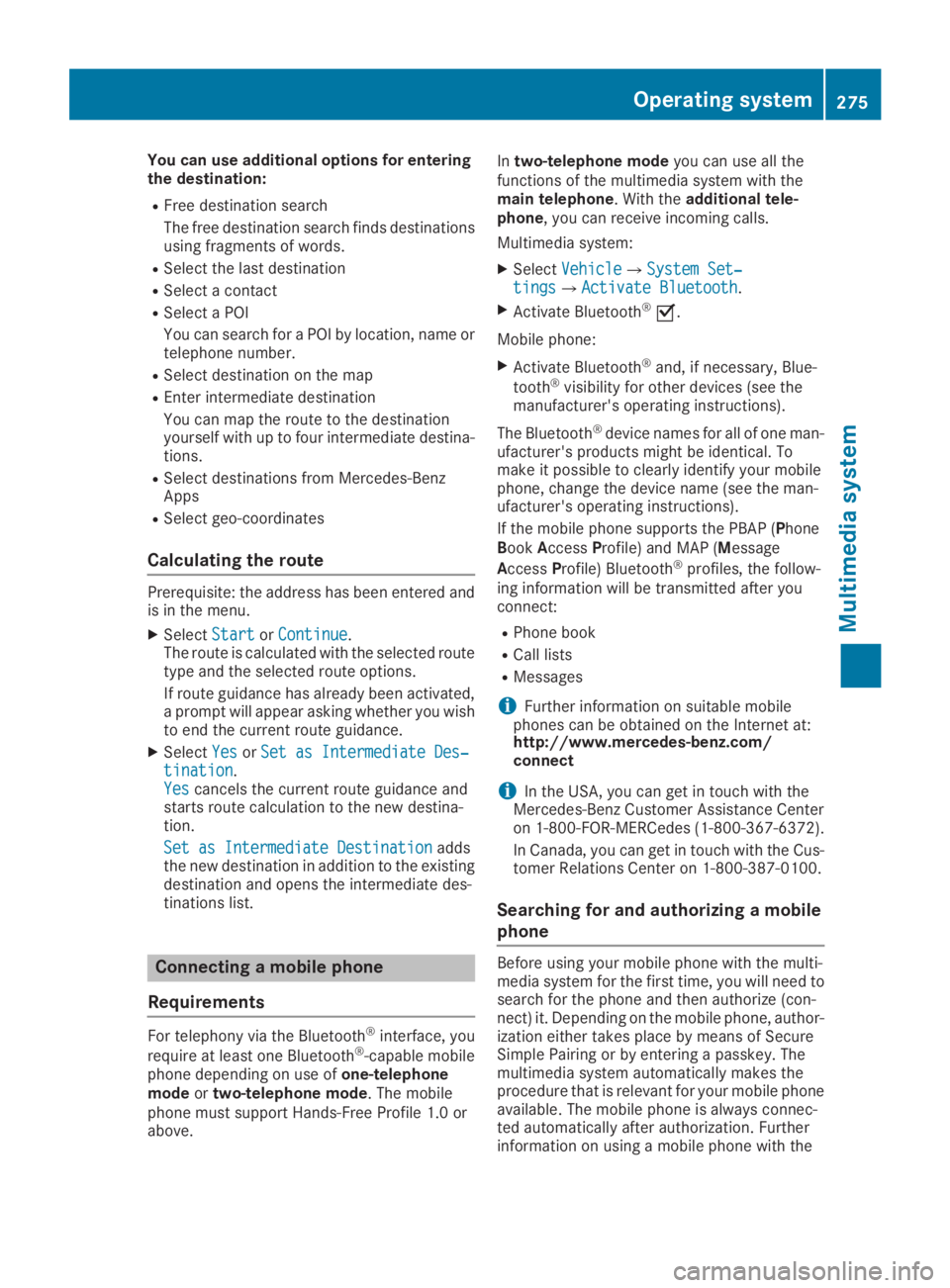
You can use additional options for enteringthe destination:
RFree destination search
The free destination search finds destinationsusing fragments of words.
RSelect the last destination
RSelect a contact
RSelect a POI
You can search for a POI by location, name ortelephone number.
RSelect destination on the map
REnter intermediate destination
You can map the route to the destinationyourself with up to four intermediate destina-tions.
RSelect destinations from Mercedes-BenzApps
RSelect geo-coordinates
Calculating the route
Prerequisite: the address has been entered andis in the menu.
XSelectStartStartorContinueContinue.The route is calculated with the selected routetype and the selected route options.
If route guidance has already been activated,a prompt will appear asking whether you wishto end the current route guidance.
XSelectYesYesorSet as Intermediate Des‐Set as Intermediate Des‐tinationtination.YesYescancels the current route guidance andstarts route calculation to the new destina-tion.
Set as Intermediate DestinationSet as Intermediate Destinationaddsthe new destination in addition to the existingdestination and opens the intermediate des-tinations list.
Connecting a mobile phone
Requirements
For telephony via the Bluetooth®interface, you
require at least one Bluetooth®-capable mobilephone depending on use ofone-telephonemodeortwo-telephone mode. The mobilephone must support Hands-Free Profile 1.0 orabove.
Intwo-telephone modeyou can use all thefunctions of the multimedia system with themain telephone. With theadditional tele-phone, you can receive incoming calls.
Multimedia system:
XSelectVehicleVehicle�{System Set‐System Set‐tingstings�{Activate BluetoothActivate Bluetooth.
XActivate Bluetooth®�s.
Mobile phone:
XActivate Bluetooth®and, if necessary, Blue-
tooth®visibility for other devices (see themanufacturer's operating instructions).
The Bluetooth®device names for all of one man-ufacturer's products might be identical. Tomake it possible to clearly identify your mobilephone, change the device name (see the man-ufacturer's operating instructions).
If the mobile phone supports the PBAP (PhoneBookAccessProfile) and MAP (Message
AccessProfile) Bluetooth®profiles, the follow-ing information will be transmitted after youconnect:
RPhone book
RCall lists
RMessages
iFurther information on suitable mobilephones can be obtained on the Internet at:http://www.mercedes-benz.com/connect
iIn the USA, you can get in touch with theMercedes-Benz Customer Assistance Centeron 1-800-FOR-MERCedes (1-800-367-6372).
In Canada, you can get in touch with the Cus-tomer Relations Center on 1-800-387-0100.
Searching for and authorizing a mobile
phone
Before using your mobile phone with the multi-media system for the first time, you will need tosearch for the phone and then authorize (con-nect) it. Depending on the mobile phone, author-ization either takes place by means of SecureSimple Pairing or by entering a passkey. Themultimedia system automatically makes theprocedure that is relevant for your mobile phoneavailable. The mobile phone is always connec-ted automatically after authorization. Furtherinformation on using a mobile phone with the
Operating system275
Multimedia system
Z
Page 278 of 370
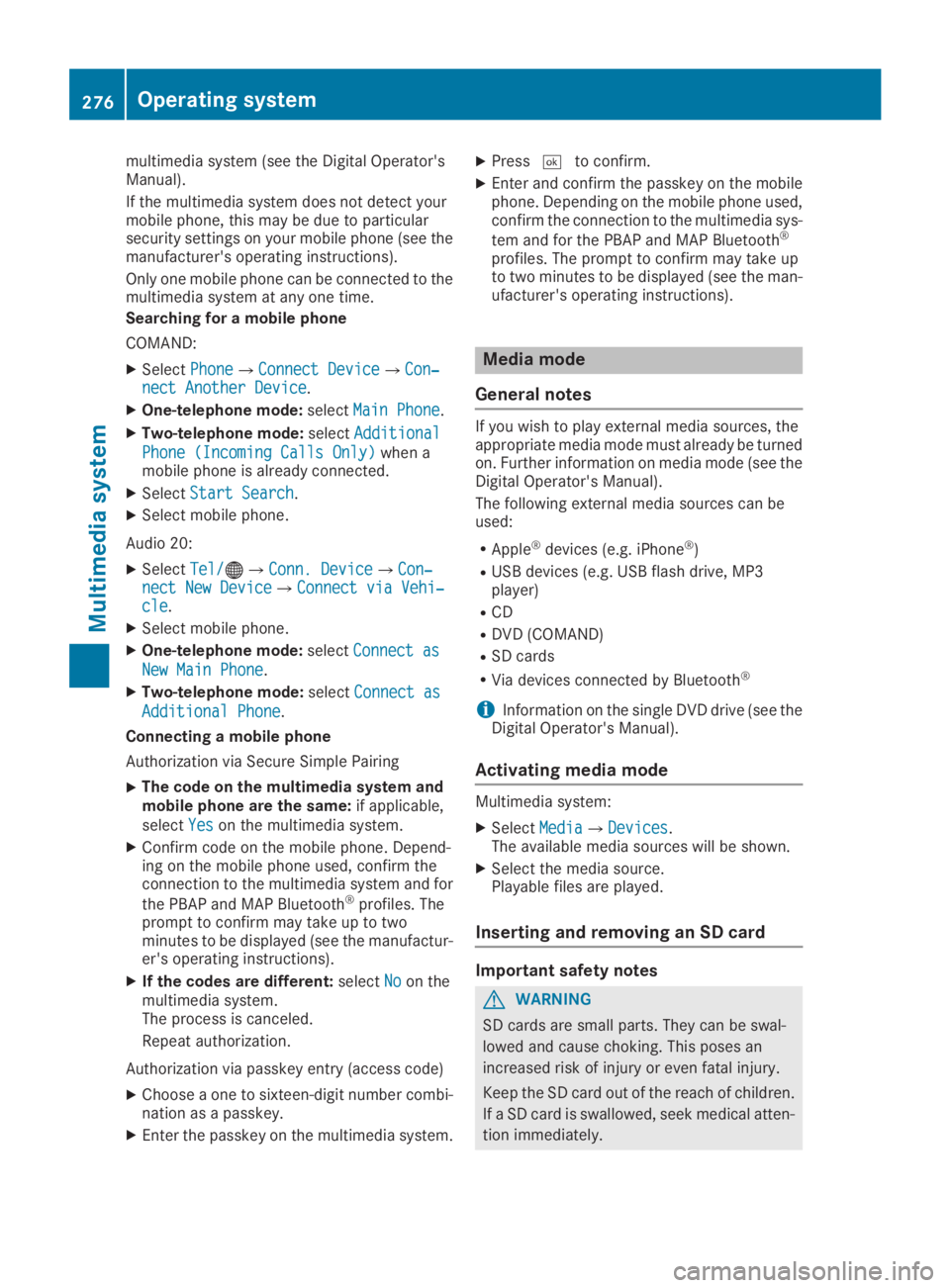
multimedia system (see the Digital Operator'sManual).
If the multimedia system does not detect yourmobile phone, this may be due to particularsecurity settings on your mobile phone (see themanufacturer's operating instructions).
Only one mobile phone can be connected to themultimedia system at any one time.
Searching for a mobile phone
COMAND:
XSelectPhonePhone�{Connect DeviceConnect Device�{Con‐Con‐nect Another Devicenect Another Device.
XOne-telephone mode:selectMain PhoneMain Phone.
XTwo-telephone mode:selectAdditionalAdditional
Phone (Incoming Calls Only)Phone (Incoming Calls Only)when amobile phone is already connected.
XSelectStart SearchStart Search.
XSelect mobile phone.
Audio 20:
XSelectTel/Tel/�
Page 280 of 370
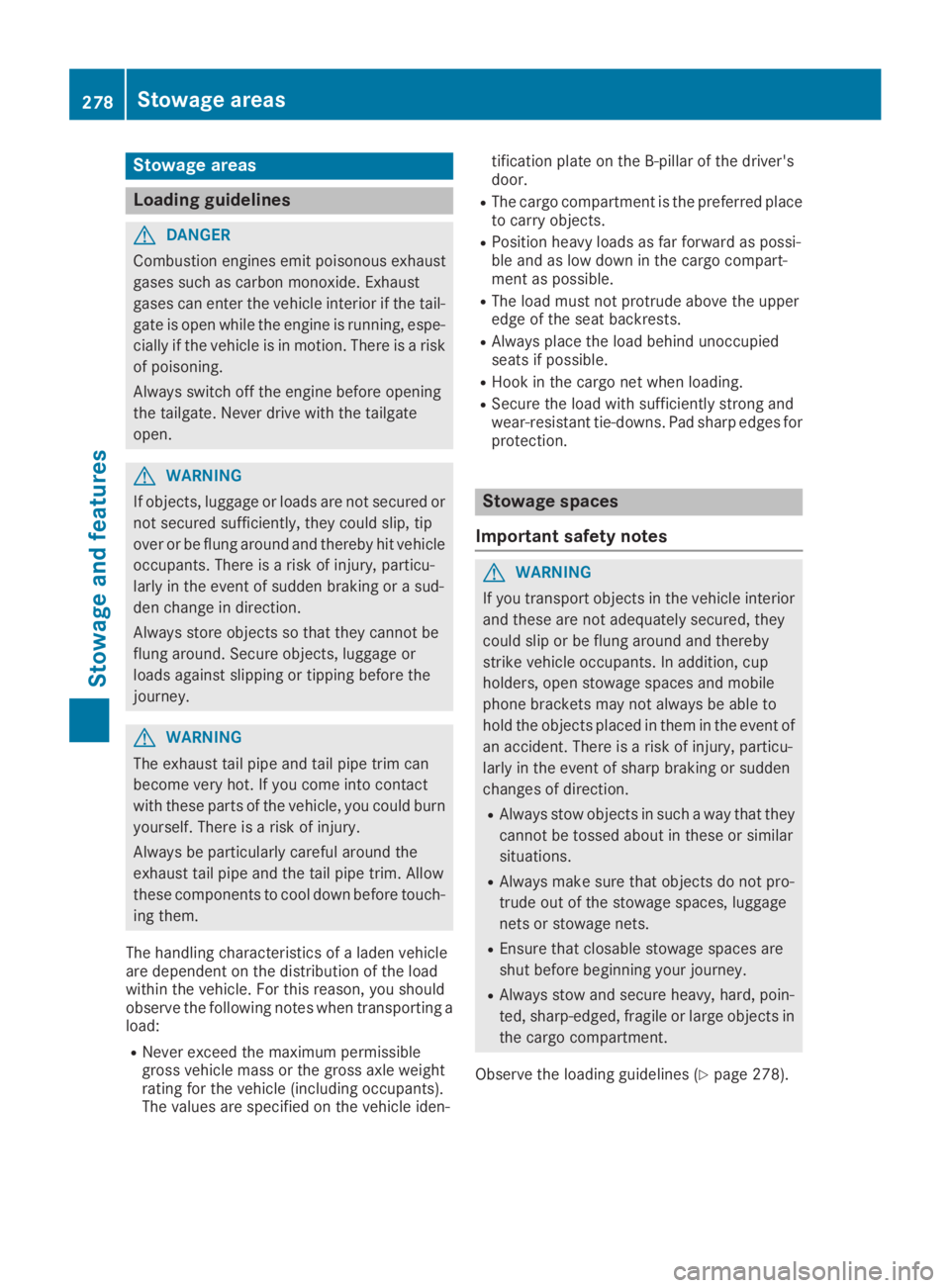
Stowage areas
Loading guidelines
GDANGER
Combustion engines emit poisonous exhaust
gases such as carbon monoxide. Exhaust
gases can enter the vehicle interior if the tail-
gate is open while the engine is running, espe-
cially if the vehicle is in motion. There is a risk
of poisoning.
Always switch off the engine before opening
the tailgate. Never drive with the tailgate
open.
GWARNING
If objects, luggage or loads are not secured or
not secured sufficiently, they could slip, tip
over or be flung around and thereby hit vehicle
occupants. There is a risk of injury, particu-
larly in the event of sudden braking or a sud-
den change in direction.
Always store objects so that they cannot be
flung around. Secure objects, luggage or
loads against slipping or tipping before the
journey.
GWARNING
The exhaust tail pipe and tail pipe trim can
become very hot. If you come into contact
with these parts of the vehicle, you could burn
yourself. There is a risk of injury.
Always be particularly careful around the
exhaust tail pipe and the tail pipe trim. Allow
these components to cool down before touch-
ing them.
The handling characteristics of a laden vehicleare dependent on the distribution of the loadwithin the vehicle. For this reason, you shouldobserve the following notes when transporting aload:
RNever exceed the maximum permissiblegross vehicle mass or the gross axle weightrating for the vehicle (including occupants).The values are specified on the vehicle iden-
tification plate on the B-pillar of the driver'sdoor.
RThe cargo compartment is the preferred placeto carry objects.
RPosition heavy loads as far forward as possi-ble and as low down in the cargo compart-ment as possible.
RThe load must not protrude above the upperedge of the seat backrests.
RAlways place the load behind unoccupiedseats if possible.
RHook in the cargo net when loading.
RSecure the load with sufficiently strong andwear-resistant tie-downs. Pad sharp edges forprotection.
Stowage spaces
Important safety notes
GWARNING
If you transport objects in the vehicle interior
and these are not adequately secured, they
could slip or be flung around and thereby
strike vehicle occupants. In addition, cup
holders, open stowage spaces and mobile
phone brackets may not always be able to
hold the objects placed in them in the event of
an accident. There is a risk of injury, particu-
larly in the event of sharp braking or sudden
changes of direction.
RAlways stow objects in such a way that they
cannot be tossed about in these or similar
situations.
RAlways make sure that objects do not pro-
trude out of the stowage spaces, luggage
nets or stowage nets.
REnsure that closable stowage spaces are
shut before beginning your journey.
RAlways stow and secure heavy, hard, poin-
ted, sharp-edged, fragile or large objects in
the cargo compartment.
Observe the loading guidelines (Ypage 278).
278Stowage areas
Stowage and features
Page 282 of 370
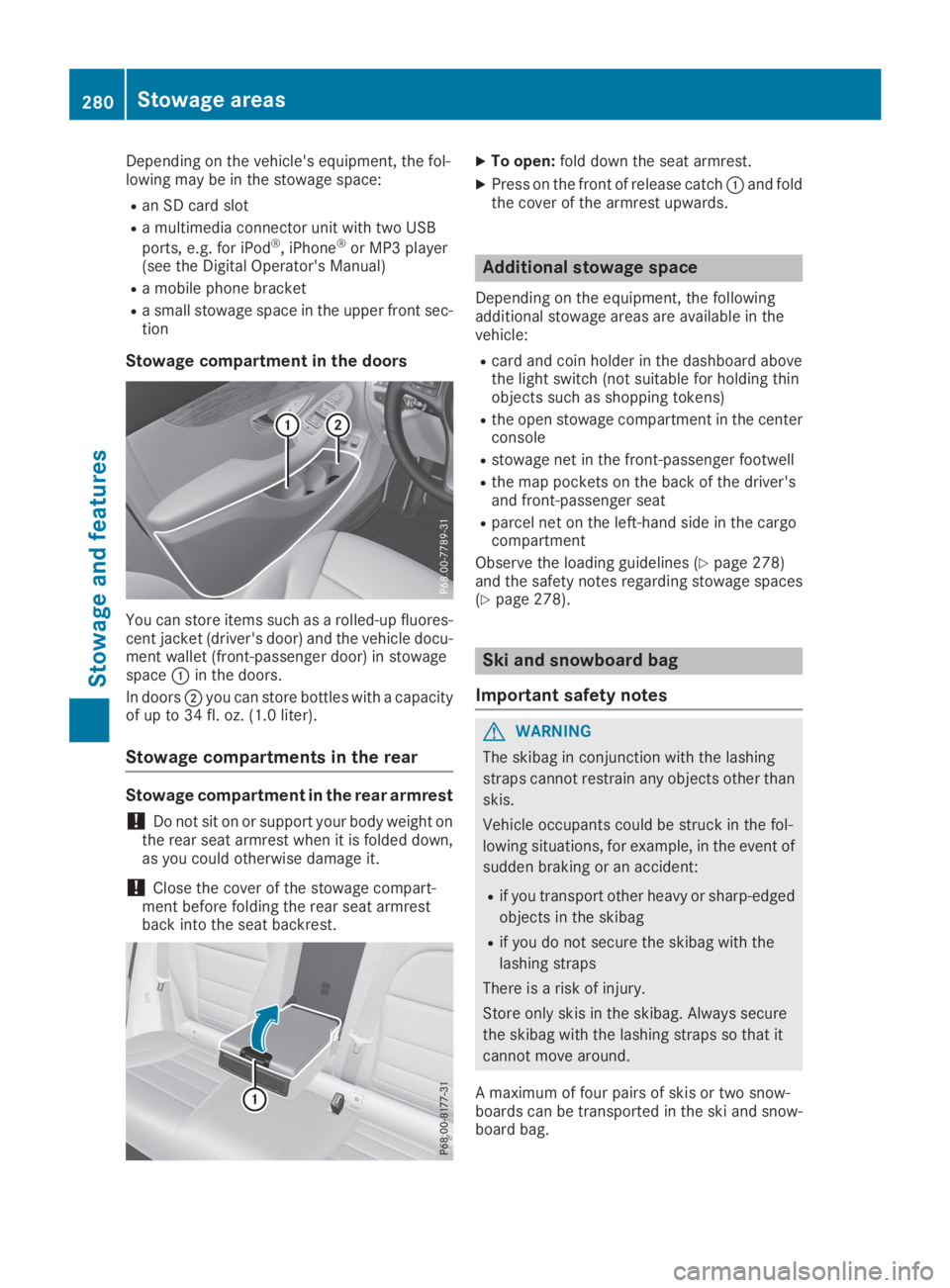
Depending on the vehicle's equipment, the fol-lowing may be in the stowage space:
Ran SD card slot
Ra multimedia connector unit with two USB
ports, e.g. for iPod®, iPhone®or MP3 player(see the Digital Operator's Manual)
Ra mobile phone bracket
Ra small stowage space in the upper front sec-tion
Stowage compartment in the doors
You can store items such as a rolled-up fluores-cent jacket (driver's door) and the vehicle docu-ment wallet (front-passenger door) in stowagespace�Cin the doors.
In doors�Dyou can store bottles with a capacityof up to 34 fl. oz. (1.0 liter).
Stowage compartments in the rear
Stowage compartment in the rear armrest
!Do not sit on or support your body weight onthe rear seat armrest when it is folded down,as you could otherwise damage it.
!Close the cover of the stowage compart-ment before folding the rear seat armrestback into the seat backrest.
XTo open:fold down the seat armrest.
XPress on the front of release catch�Cand foldthe cover of the armrest upwards.
Additional stowage space
Depending on the equipment, the followingadditional stowage areas are available in thevehicle:
Rcard and coin holder in the dashboard abovethe light switch (not suitable for holding thinobjects such as shopping tokens)
Rthe open stowage compartment in the centerconsole
Rstowage net in the front-passenger footwell
Rthe map pockets on the back of the driver'sand front-passenger seat
Rparcel net on the left-hand side in the cargocompartment
Observe the loading guidelines (Ypage 278)and the safety notes regarding stowage spaces(Ypage 278).
Ski and snowboard bag
Important safety notes
GWARNING
The skibag in conjunction with the lashing
straps cannot restrain any objects other than
skis.
Vehicle occupants could be struck in the fol-
lowing situations, for example, in the event of
sudden braking or an accident:
Rif you transport other heavy or sharp-edged
objects in the skibag
Rif you do not secure the skibag with the
lashing straps
There is a risk of injury.
Store only skis in the skibag. Always secure
the skibag with the lashing straps so that it
cannot move around.
A maximum of four pairs of skis or two snow-boards can be transported in the ski and snow-board bag.
280Stowage areas
Stowage an d features
Page 287 of 370
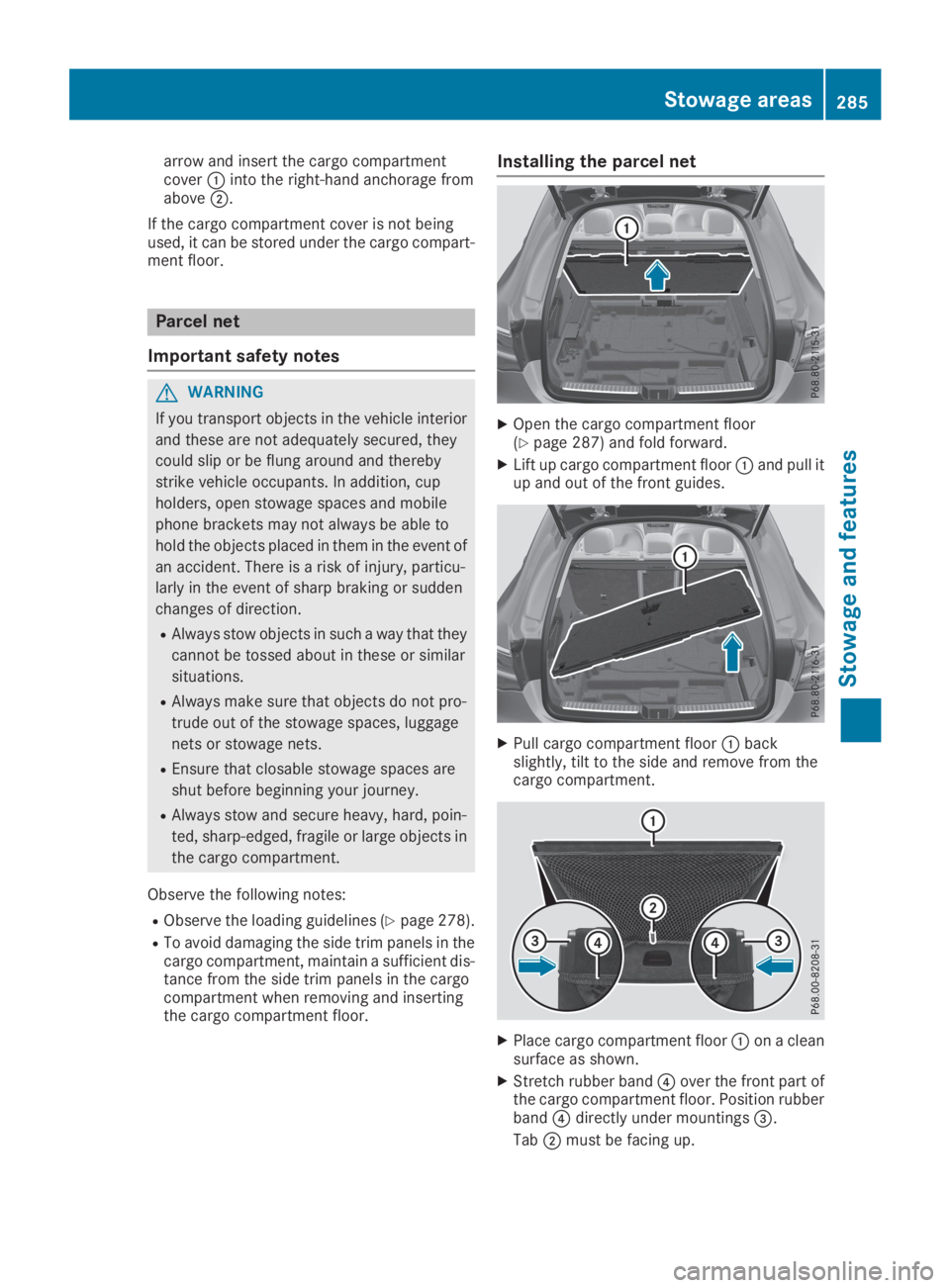
arrow and insert the cargo compartmentcover�Cinto the right-hand anchorage fromabove�D.
If the cargo compartment cover is not beingused, it can be stored under the cargo compart-ment floor.
Parcel net
Important safety notes
GWARNING
If you transport objects in the vehicle interior
and these are not adequately secured, they
could slip or be flung around and thereby
strike vehicle occupants. In addition, cup
holders, open stowage spaces and mobile
phone brackets may not always be able to
hold the objects placed in them in the event of
an accident. There is a risk of injury, particu-
larly in the event of sharp braking or sudden
changes of direction.
RAlways stow objects in such a way that they
cannot be tossed about in these or similar
situations.
RAlways make sure that objects do not pro-
trude out of the stowage spaces, luggage
nets or stowage nets.
REnsure that closable stowage spaces are
shut before beginning your journey.
RAlways stow and secure heavy, hard, poin-
ted, sharp-edged, fragile or large objects in
the cargo compartment.
Observe the following notes:
RObserve the loading guidelines (Ypage 278).
RTo avoid damaging the side trim panels in thecargo compartment, maintain a sufficient dis-tance from the side trim panels in the cargocompartment when removing and insertingthe cargo compartment floor.
Installing the parcel net
XOpen the cargo compartment floor(Ypage 287) and fold forward.
XLift up cargo compartment floor�Cand pull itup and out of the front guides.
XPull cargo compartment floor�Cbackslightly, tilt to the side and remove from thecargo compartment.
XPlace cargo compartment floor�Con a cleansurface as shown.
XStretch rubber band�
Page 291 of 370
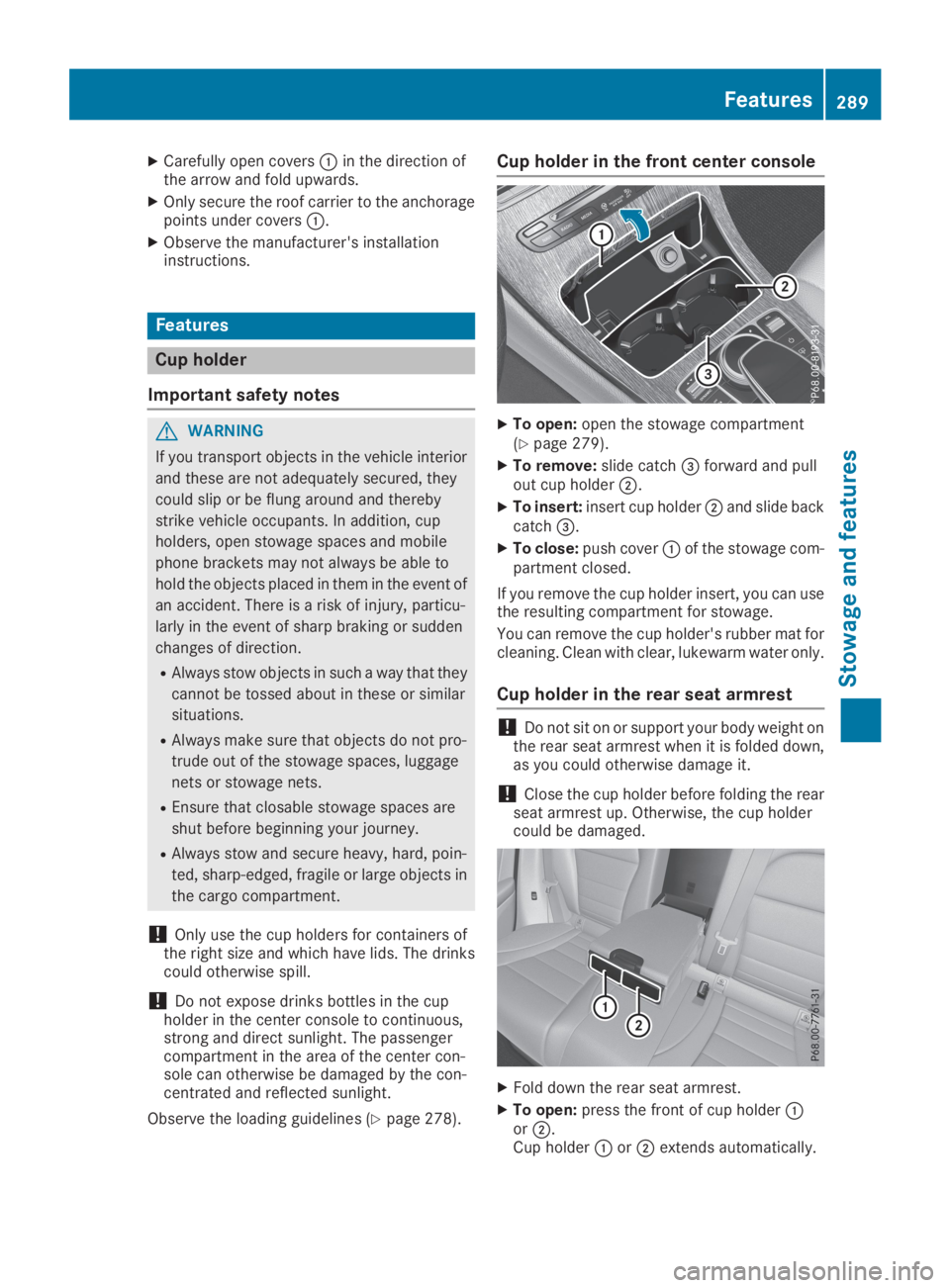
XCarefully open covers�Cin the direction ofthe arrow and fold upwards.
XOnly secure the roof carrier to the anchoragepoints under covers�C.
XObserve the manufacturer's installationinstructions.
Features
Cup holder
Important safety notes
GWARNING
If you transport objects in the vehicle interior
and these are not adequately secured, they
could slip or be flung around and thereby
strike vehicle occupants. In addition, cup
holders, open stowage spaces and mobile
phone brackets may not always be able to
hold the objects placed in them in the event of
an accident. There is a risk of injury, particu-
larly in the event of sharp braking or sudden
changes of direction.
RAlways stow objects in such a way that they
cannot be tossed about in these or similar
situations.
RAlways make sure that objects do not pro-
trude out of the stowage spaces, luggage
nets or stowage nets.
REnsure that closable stowage spaces are
shut before beginning your journey.
RAlways stow and secure heavy, hard, poin-
ted, sharp-edged, fragile or large objects in
the cargo compartment.
!Only use the cup holders for containers ofthe right size and which have lids. The drinkscould otherwise spill.
!Do not expose drinks bottles in the cupholder in the center console to continuous,strong and direct sunlight. The passengercompartment in the area of the center con-sole can otherwise be damaged by the con-centrated and reflected sunlight.
Observe the loading guidelines (Ypage 278).
Cup holder in the front center console
XTo open:open the stowage compartment(Ypage 279).
XTo remove:slide catch�
Page 294 of 370
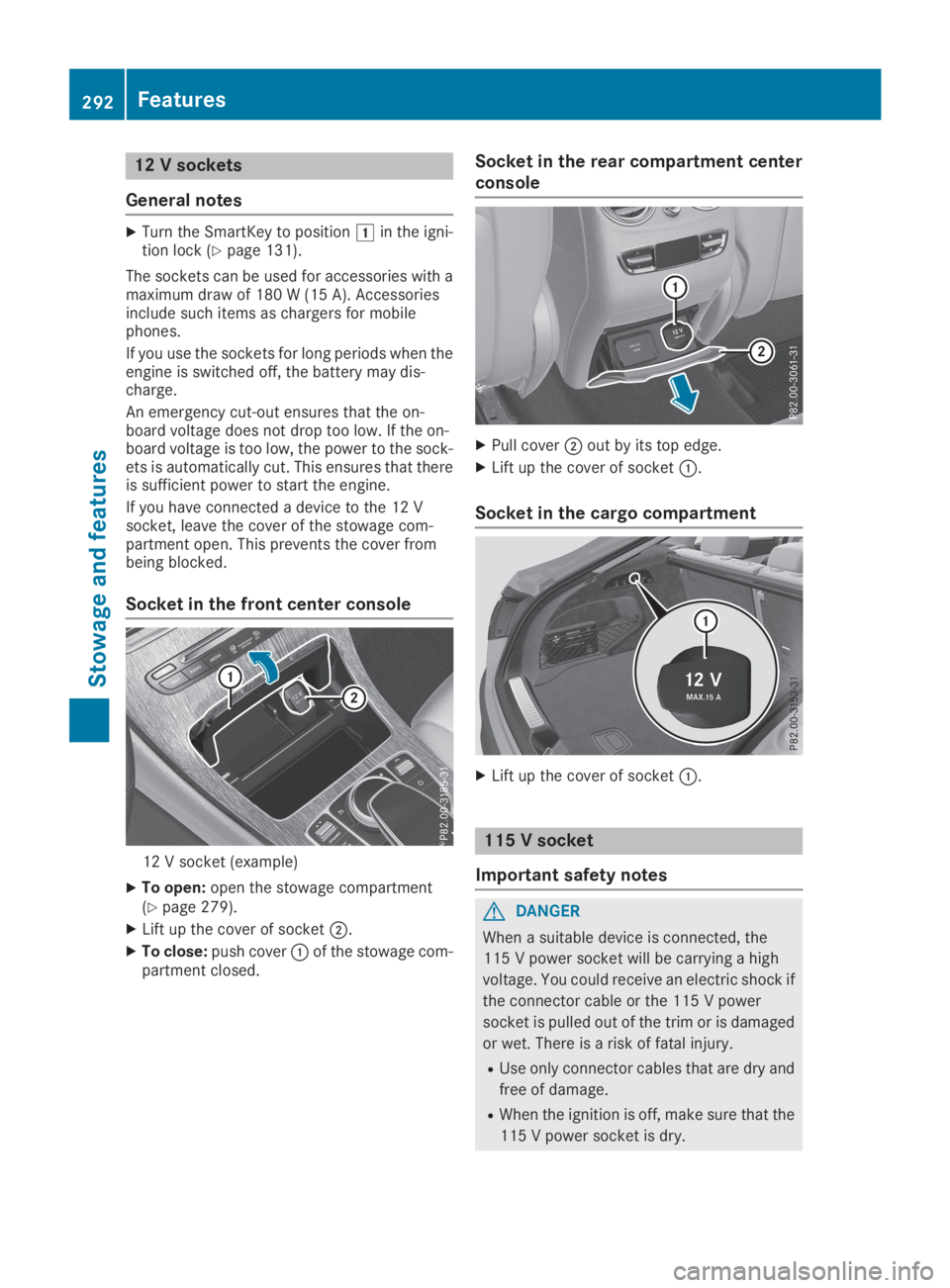
12 V sockets
General notes
XTurn the SmartKey to position�Gin the igni-tion lock (Ypage 131).
The sockets can be used for accessories with amaximum draw of 180 W (15 A). Accessoriesinclude such items as chargers for mobilephones.
If you use the sockets for long periods when theengine is switched off, the battery may dis-charge.
An emergency cut-out ensures that the on-board voltage does not drop too low. If the on-board voltage is too low, the power to the sock-ets is automatically cut. This ensures that thereis sufficient power to start the engine.
If you have connected a device to the 12 Vsocket, leave the cover of the stowage com-partment open. This prevents the cover frombeing blocked.
Socket in the front center console
12 V socket (example)
XTo open:open the stowage compartment(Ypage 279).
XLift up the cover of socket�D.
XTo close:push cover�Cof the stowage com-partment closed.
Socket in the rear compartment center
console
XPull cover�Dout by its top edge.
XLift up the cover of socket�C.
Socket in the cargo compartment
XLift up the cover of socket�C.
115 V socket
Important safety notes
GDANGER
When a suitable device is connected, the
115 V power socket will be carrying a high
voltage. You could receive an electric shock if
the connector cable or the 115 V power
socket is pulled out of the trim or is damaged
or wet. There is a risk of fatal injury.
RUse only connector cables that are dry and
free of damage.
RWhen the ignition is off, make sure that the
115 V power socket is dry.
292Features
Stowage and features
Page 296 of 370

Problems with the 115 V power socket
ProblemPossible causes/consequences and�P�PSolutions
The warning lamp on the115 V power socket isnot lit.
The on-board voltage is too low because the battery is too weak.
XStart the engine.
or
XCharge the battery (Ypage 321).
If the indicator lamp still does not light up:
XVisit a qualified specialist workshop.
The temperature of the DC/AC converter is temporarily too high.
XRemove the electronic device connector from the 115 V socket.
XLet the DC/AC converter cool down.
If the indicator lamp still does not light up after cooling down theconverter:
XVisit a qualified specialist workshop.
You have connected an electronic device that has a constant nominalpower of less than 150 watts, but has a very high switch-on current.This device will not work. If you connect such a device, the 115 Vpower socket will not supply it with power.
XConnect a suitable electronic device.
Mercedes-Benz emergency call sys-
tem
Information on these requirements can be foundin the Digital Operator's Manual.
XTo open:press cover�C.
XTo make an emergency call:press SOS but-ton�Dbriefly.The indicator lamp in SOS button�Dflashesuntil the emergency call is concluded.
XWait for a voice connection to the Mercedes-Benz emergency call center.
XAfter the emergency call, close cover�C.
You will see a message if:
Ra connection to the Mercedes-Benz emer-gency call center cannot be established
Ra call has not been automatically forwardedto the public emergency call center
In this case, dial the emergency number onyour mobile phone.
Further information on the Mercedes-Benzemergency call system can be found in the Dig-ital Operator's Manual.
Mercedes me connect
General notes
The display of the multimedia system indicatesthat a call is active. During the call, you can callup the navigation menu by pressing the�